We may not have the course you’re looking for. If you enquire or give us a call on 800969236 and speak to our training experts, we may still be able to help with your training requirements.
Training Outcomes Within Your Budget!
We ensure quality, budget-alignment, and timely delivery by our expert instructors.
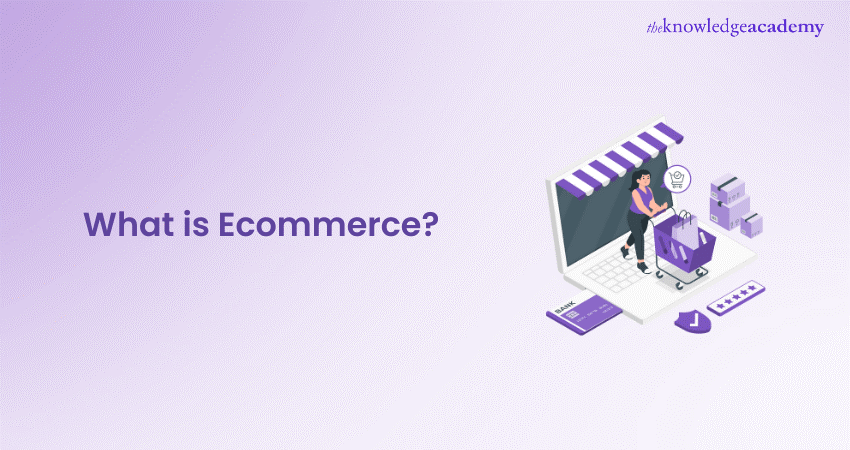
Picture this: You’re lounging on your couch, sipping your favourite tea, and within minutes, you've ordered everything you need – from Amazon- your go-to Ecommerce website, from groceries to gadgets. But What is Ecommerce? It’s like having a 24/7 personal shopping assistant at your fingertips.
In this blog, we will dive deep into What is Ecommerce, exploring its origins, how it works, and the various types that exist. This blog will help you grasp the full picture of what Ecommerce is and why it has become an indispensable part of our daily lives. Ready to explore the world of Ecommerce? Let’s get started!
Table of Contents
1) What is Ecommerce?
2) How Does Ecommerce Work?
3) Different Types of Ecommerce
4) How to Launch an Ecommerce Business on an Online Marketplace?
5) Benefits and Drawbacks of Ecommerce
6) Difference Between Ecommerce Business and Traditional Business Models
7) Conclusion
What is Ecommerce?
Ecommerce refers to buying and selling goods and services over the internet. This broad term includes online shopping, banking, digital payments, and virtual auctions. It encompasses a wide range of activities conducted through digital platforms.
Ecommerce enables businesses to reach a global audience, offering convenience to consumers. They can purchase products or services from the comfort of their homes. Whether it's a small business or a large corporation, Ecommerce transcends geographical boundaries.
History of Ecommerce
The history of Ecommerce, or electronic commerce, is a fascinating journey that has transformed the way we buy and sell goods and services. Here are some key milestones:
1) Early Beginnings (1960s - 1980s):
a) Electronic Data Interchange (EDI): In the 1960s, EDI was developed to allow businesses to exchange documents like purchase orders and invoices electronically. This system laid the groundwork for Ecommerce by automating and streamlining business transactions.
b) Electronic Funds Transfer (EFT): In the 1970s, EFT systems enabled the electronic transfer of money between banks, paving the way for online payments.
2) The Birth of the Internet and Online Shopping (1990s):
a) World Wide Web: Invented by Tim Berners-Lee in 1989, the World Wide Web became publicly accessible in 1991, revolutionising how information was shared and accessed.
b) First Online Transactions: In 1994, the first secure online transaction was made on NetMarket, marking the beginning of online retail.
3) Growth and Expansion (2000s - 2010s):
a) Amazon and eBay: Founded in the mid-1990s, these platforms became giants in the Ecommerce world, offering a wide range of products and services.
b) Mobile Commerce: With the advent of smartphones and tablets, mobile commerce (m-commerce) emerged, allowing consumers to shop on the go.
4) Modern Era (2020s):
a) Global Reach: Ecommerce has become a global phenomenon, with platforms like Alibaba and Shopify enabling businesses of all sizes to reach international markets.
b) Technological Advancements: Innovations such as artificial intelligence, augmented reality, and blockchain are continually shaping the future of Ecommerce.
How Does Ecommerce Work?
Ecommerce, or electronic commerce, involves buying and selling goods and services over the internet. Here’s how it works:
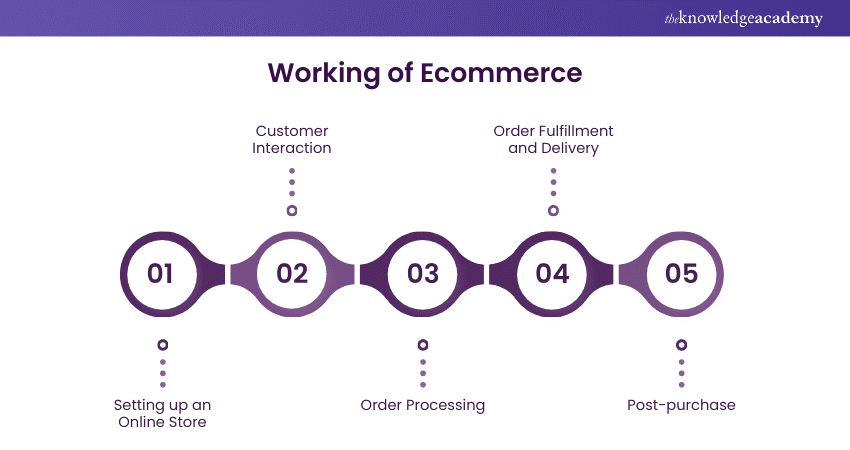
1) Setting up an Online Store:
a) Website Creation: Businesses create an Ecommerce website using platforms like Shopify, WooCommerce, or Magento. These platforms provide tools to list products, manage inventory, and process payments.
b) Product Listings: Products are listed with descriptions, prices, and images. This helps customers browse and choose what they want to buy.
2) Customer Interaction:
a) Browsing: Customers visit the online store, browse through the product categories, and add items to their shopping cart.
b) Payment: Once ready to purchase, customers proceed to checkout. They enter their shipping details and choose a payment method, such as credit/debit cards, digital wallets (like PayPal), or other online payment systems.
3) Order Processing:
a) Order Confirmation: After payment, the order is confirmed, and the customer receives a confirmation email with the order details.
b) Inventory Management: The system updates the inventory to reflect the sold items.
4) Order Fulfillment and Delivery:
a) Shipping: The business prepares the order for shipping. This can involve packaging the product and generating shipping labels.
b) Delivery: The order is shipped to the customer’s address. Some businesses offer options like store pickup or local delivery.
5) Post-purchase:
a) Customer Service: Businesses provide customer support for any issues related to the order, such as returns or exchanges.
b) Feedback: Customers can leave reviews and feedback, which helps other shoppers and the business improve its services.
Explore Shopify's features and build your online presence with expert guidance in our Introduction To Shopify – join now!
Different Types of Ecommerce
Ecommerce can be categorised into several types based on the nature of the transactions. Understanding these categories is crucial for businesses looking to enter the Ecommerce space.
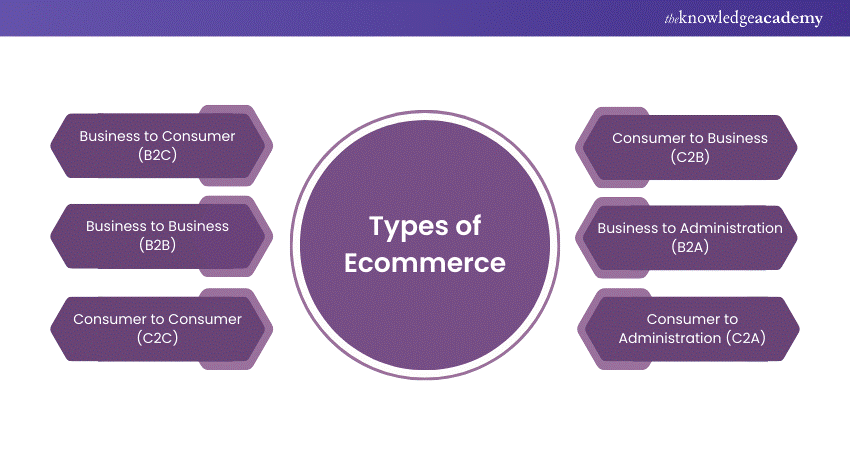
1) Business to Consumer (B2C): This is the most common type, where businesses sell products or services directly to consumers. Examples include online retailers like Amazon, ASOS, and Tesco.
2) Business to Business (B2B): In this model, businesses sell products or services to other businesses. Examples include Alibaba and other bulk suppliers.
3) Consumer to Consumer (C2C): This involves transactions between consumers, often facilitated by a third-party platform. Examples include eBay, Gumtree, and Depop.
4) Consumer to Business (C2B): Here, individuals sell products or services to businesses. Examples include freelance platforms like Upwork and Fiverr.
5) Business to Administration (B2A): This model involves transactions between businesses and public administration or government bodies. Examples include government procurement systems.
6) Consumer to Administration (C2A): In this model, consumers interact with government or public administration. Examples include paying taxes or applying for government services online.
Learn to build, manage, and optimise your WooCommerce store with our comprehensive, hands-on WooCommerce Training – sign up now!
How to Launch an Ecommerce Business on an Online Marketplace?
Launching an Ecommerce business in an online marketplace can be a rewarding venture, but it requires careful planning and strategic steps. Here's a step to help you navigate the process, from defining your business model to successfully launching your store.
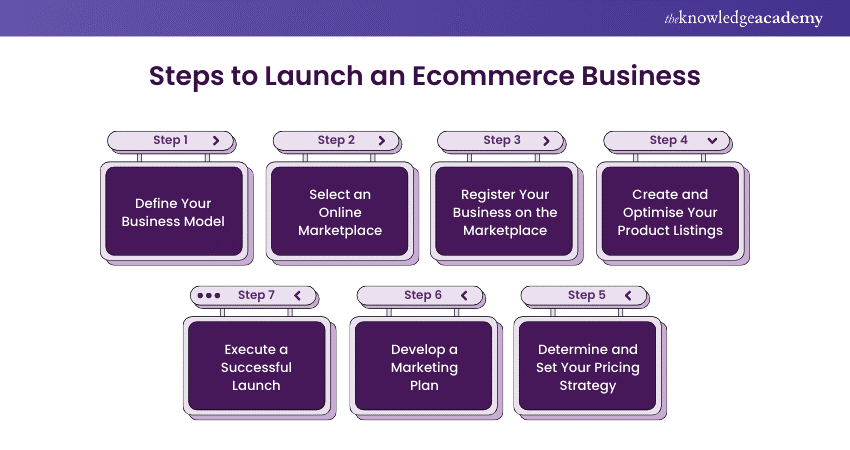
Step 1 - Define Your Business Model
Begin by identifying a potentially profitable business idea that aligns with your skills and interests. Having in-depth knowledge about the products or services you plan to sell will give you a competitive edge.
Step 2 - Select an Online Marketplace
Select an online marketplace where you will set up your store. Popular options provide access to a large customer base, growth tools, and customer relationship services. While creating your own website is an option, many sellers prefer established marketplaces for their convenience and reach.
Step 3 - Register Your Business on the Marketplace
Create an account on your chosen marketplace. Most platforms offer a straightforward sign-up process. Follow the instructions carefully and have your documents ready, as you may need to provide personal information such as your name and bank details.
Step 4 - Create and Optimise Your Product Listings
Start setting up your online store by listing your products in appropriate categories. Ensure each product listing is detailed and informative, giving potential buyers a clear understanding of what they are purchasing. Well-crafted listings can attract more customers and boost sales.
Step 5 - Determine and Set Your Pricing Strategy
Pricing your products can be challenging due to competition. Utilise pricing tools to adjust prices automatically based on your set rules. This helps you stay competitive without constantly revisiting your listings. Ensure your prices are reasonable to attract and retain customers.
Step 6 - Develop a Marketing Plan
Effective marketing is crucial for generating sales. Leverage inexpensive tools like social media to create a robust marketing strategy. Plan both a launch strategy and a post-launch strategy to maintain a steady flow of customers.
Step 7 - Execute a Successful Launch
With everything in place, it’s time to officially launch your business. Ensure your inventory is well-stocked and ready to meet demand. Remember, making a strong first impression is vital for long-term success.
Elevate your brand with advanced digital marketing tools with our Digital Marketing Tools Training – join now!
Benefits and Drawbacks of Ecommerce
Ecommerce offers numerous benefits, but it also comes with its own set of challenges. Understanding these can help you navigate the Ecommerce landscape effectively.
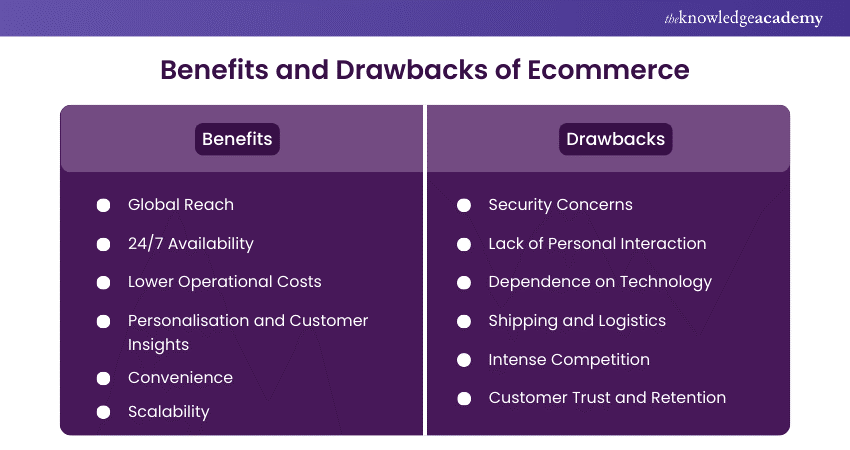
Benefits:
1) Global Reach: Ecommerce allows businesses to reach a global audience, breaking geographical barriers and expanding their customer base.
2) 24/7 Availability: Online stores are open 24/7, providing customers the convenience to shop at any time, which can lead to increased sales.
3) Lower Operational Costs: Running an online store often incurs lower costs compared to a physical store. Expenses such as rent, utilities, and in-store staff can be significantly reduced.
4) Personalisation and Customer Insights: Ecommerce Platforms can collect data on customer behaviour, preferences, and purchase history, enabling personalised marketing and improved customer service.
5) Convenience: Customers can shop from the comfort of their homes, compare prices easily, and have products delivered to their doorstep.
6) Scalability: Ecommerce businesses can scale more easily than physical stores. Adding new products or expanding to new markets can be done with minimal additional costs.
Drawbacks:
1) Security Concerns: Online transactions can be vulnerable to security breaches, including hacking and fraud, which can undermine customer trust.
2) Lack of Personal Interaction: The absence of face-to-face interaction can make it challenging to build personal relationships with customers and provide immediate assistance.
3) Dependence on Technology: Ecommerce relies heavily on technology, and any technical issues, such as website downtime or payment gateway failures, can disrupt business operations.
4) Shipping and Logistics: Managing shipping and logistics can be complex and costly, especially for international orders. Delays and shipping errors can negatively impact customer satisfaction.
5) Intense Competition: The online marketplace is highly competitive, with many businesses vying for the same customers. This can lead to price wars and reduced profit margins.
6) Customer Trust and Retention: Building trust with customers can be more challenging online, and retaining customers requires consistent effort and excellent service.
Elevate your Ecommerce success by mastering product content creation with our expert-led Product Content For E-Commerce Training today!
Difference Between Ecommerce Business and Traditional Business Models
Ecommerce and traditional business models differ significantly in various aspects, each offering unique advantages and challenges.
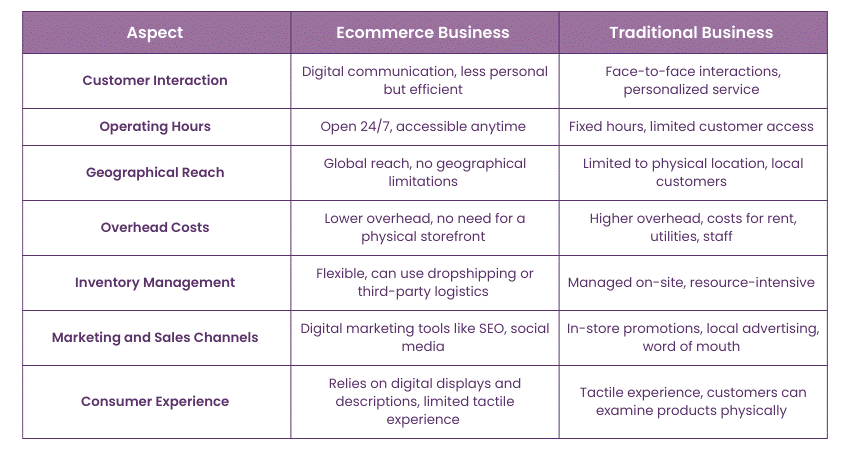
1) Customer Interaction: Traditional businesses involve face-to-face interactions, allowing for personalised customer service. In contrast, Ecommerce businesses rely on digital communication, which can be less personal but more efficient.
2) Operating Hours: Traditional businesses typically operate during fixed hours, limiting customer access. Ecommerce stores, on the other hand, are open 24/7, providing customers with the convenience of shopping anytime, anywhere.
3) Geographical Reach: Traditional businesses are often limited by their physical location, serving customers in a specific area. Ecommerce businesses, however, have the ability to reach a global audience, breaking down geographical barriers.
4) Overhead Costs: Traditional businesses usually incur higher overhead costs, such as rent, utilities, and staffing for a physical storefront. Ecommerce businesses often have lower overhead, as they don't require a physical location, reducing expenses related to property and in-person staff.
5) Inventory Management: Traditional businesses manage physical inventory on-site, which can be resource-intensive. Ecommerce businesses can use various models like dropshipping or third-party logistics, allowing for more flexible and often cost-effective inventory management.
6) Marketing and Sales Channels: Traditional businesses rely heavily on in-store promotions, local advertising, and word of mouth. Ecommerce businesses have access to a wide array of digital marketing tools, including social media, SEO, and email marketing, enabling them to reach a larger and more targeted audience.
7) Consumer Experience: Traditional businesses offer a tactile experience where customers can physically examine products before purchasing. Ecommerce uses digital displays, but detailed images, reviews, and return policies help reduce potential customer disconnect.
Unlock the secrets to Ecommerce success with our Ecommerce Strategy Course and elevate your digital business strategy today!
Conclusion
So, after diving into What is Ecommerce, it’s clear that this digital marketplace is more than just a trend - it's a fundamental shift in how we interact with businesses and shop. Whether you're a consumer or an entrepreneur, understanding Ecommerce is essential to navigating and thriving in today's fast-paced, online-driven economy.
Transform your career with cutting-edge Digital Marketing Courses that provide practical skills and real-world expertise!
Frequently Asked Questions

Ecommerce is used for its convenience, global reach, and cost-effectiveness. It allows businesses to operate 24/7, connecting with customers and selling products or services online efficiently.

Yes, Amazon is a leading Ecommerce platform. It facilitates the buying and selling of a vast range of products online. Amazon connects millions of customers and sellers globally through its digital marketplace.

The Knowledge Academy takes global learning to new heights, offering over 30,000 online courses across 490+ locations in 220 countries. This expansive reach ensures accessibility and convenience for learners worldwide.
Alongside our diverse Online Course Catalogue, encompassing 19 major categories, we go the extra mile by providing a plethora of free educational Online Resources like News updates, Blogs, videos, webinars, and interview questions. Tailoring learning experiences further, professionals can maximise value with customisable Course Bundles of TKA.

The Knowledge Academy’s Knowledge Pass, a prepaid voucher, adds another layer of flexibility, allowing course bookings over a 12-month period. Join us on a journey where education knows no bounds.

The Knowledge Academy offers various Digital Marketing Courses, including Ecommerce Strategy Course, Certified Artificial Intelligence (AI) for Digital Marketing Training, Product Content for Ecommerce Training and Pinterest Marketing Course. These courses cater to different skill levels, providing comprehensive insights into Dropshipping Tips.
Our Digital Marketing Blogs cover a range of topics related to Ecommerce, offering valuable resources, best practices, and industry insights. Whether you are a beginner or looking to advance your Digital Marketing skills, The Knowledge Academy's diverse courses and informative blogs have got you covered.
Upcoming Digital Marketing Resources Batches & Dates
Date
 Ecommerce Strategy Course
Ecommerce Strategy Course
Fri 28th Feb 2025
Fri 4th Apr 2025
Fri 27th Jun 2025
Fri 29th Aug 2025
Fri 24th Oct 2025
Fri 5th Dec 2025







 Top Rated Course
Top Rated Course



 If you wish to make any changes to your course, please
If you wish to make any changes to your course, please


